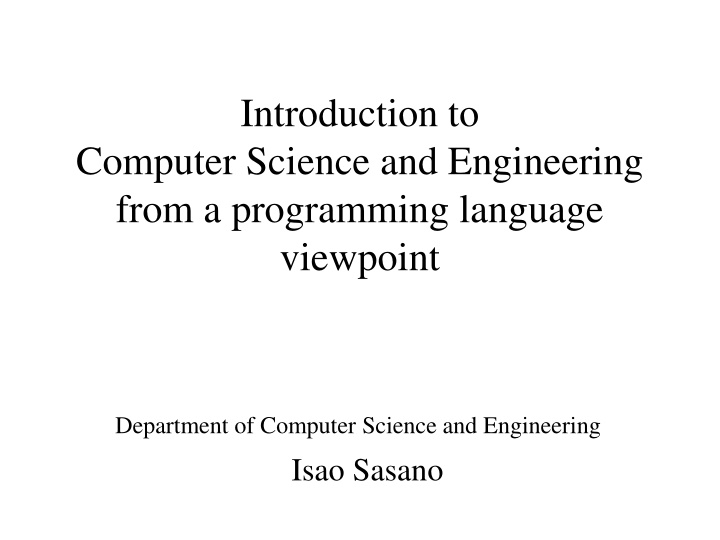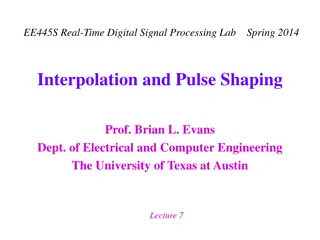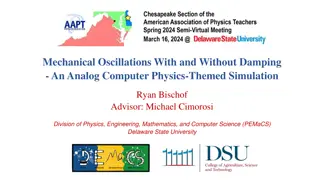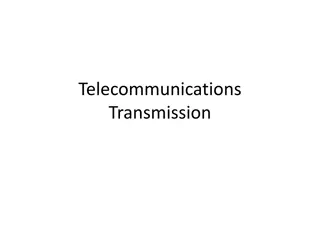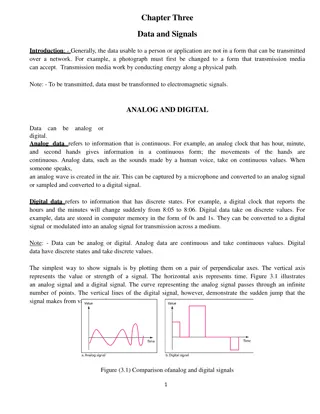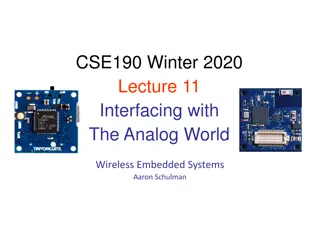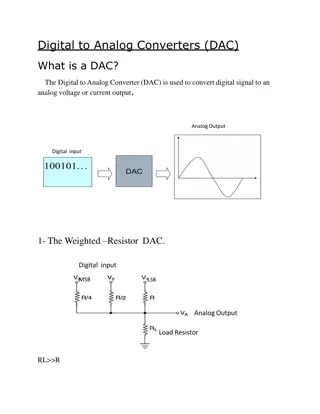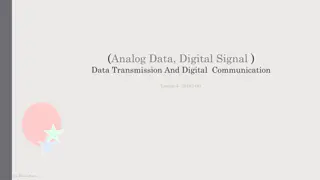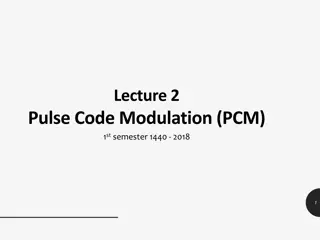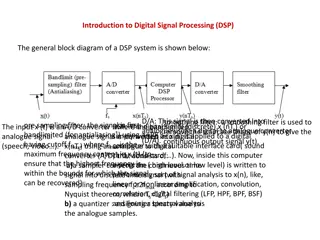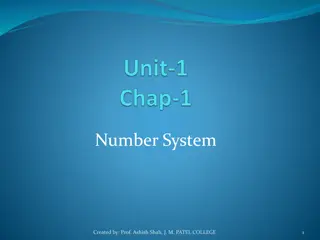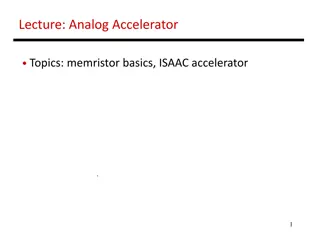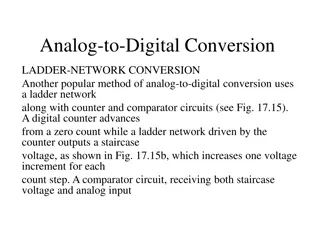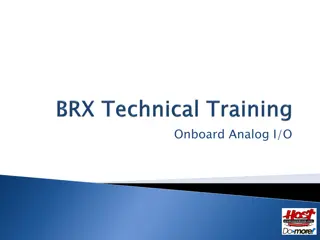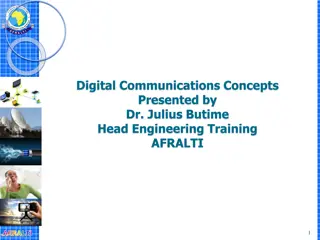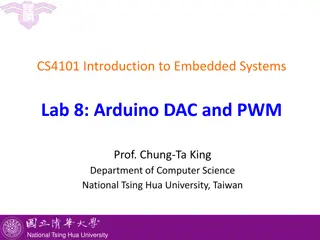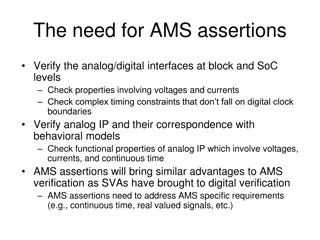Overview of Computer Science: From Analog to Digital Computing
Explore the evolution of computing from analog devices like sundials and slide rules to mechanical digital computers by Charles Babbage, and the groundbreaking ENIAC - the first general-purpose digital computer. Delve into the concept of encoding information in digital computers using binary numbers and various character encoding schemes like Unicode and Shift-JIS.
Uploaded on Sep 28, 2024 | 1 Views
Download Presentation

Please find below an Image/Link to download the presentation.
The content on the website is provided AS IS for your information and personal use only. It may not be sold, licensed, or shared on other websites without obtaining consent from the author.If you encounter any issues during the download, it is possible that the publisher has removed the file from their server.
You are allowed to download the files provided on this website for personal or commercial use, subject to the condition that they are used lawfully. All files are the property of their respective owners.
The content on the website is provided AS IS for your information and personal use only. It may not be sold, licensed, or shared on other websites without obtaining consent from the author.
E N D
Presentation Transcript
Introduction to Computer Science and Engineering from a programming language viewpoint Department of Computer Science and Engineering Isao Sasano
Self Introduction Self introduction Isao Sasano, Professor, Department of Computer Science and Engineering, College of Engineering, Shibaura Institute of Technology. Ph.D. (March 2002, University of Tokyo) (The thesis is about program transformations.) My current research is in programming languages (in particular, tools for programming support). I introduce computer science from the view point of programming languages. 2
Analog computers Compute by using physical phenomena Sundial --- a device that tells the time of day (B.C. 3500, Egypt) Slide rule (slipstick) --- a mechanical analog computer to calculate multiplication, division, exponents, roots, logarithms and trigonometry, but not for addition or subtraction (17thcentury, UK) Differential analyzer --- a mechanical device to integrate differential equations (19thcentury, France) Various other analog computers to calculate various things. Computation is not so slow but not so accurate. What is computed has to be designed beforehand. Nowadays analog computers are not so used and researched.
Mechanical digital computer (for polynomials) Difference engine developed by Charles Babbage, 1791- 1871, UK. A mechanical calculator designed to tabulate polynomial functions. Various functions including logarithmic or trigonometric ones can be approximated by polynomials. It could be used for making many useful tables, although Babbage failed to physically construct the difference engine.
A general purpose digital computer ENIAC, University of Pennsylvania, US, 1946. Vacuum tube 17,000, 150kW, 167m2. Used for making tables for firing angles of bombs.
Encoding When processing information on digital computers, we have to express the information by a sequence of symbols (typically 0 and 1, so binary numbers). This is referred to as encoding. Although ENIAC uses decimal numbers, modern computers use binary numbers. There are various character encoding (correspondence between characters and numbers). Unicode, Shift-JIS, etc. are often used in Japan. (ex) number 1 1 (00000001, a binary number, 1 byte) Character a 97 (01100001, a binary number, 1 byte) String ab 97 98 0 (01100001 01100010 00000000, three binary numbers, 3 byte. Suppose 0 represents the end of string.)
Images Divide an image into cells (discretization) and then express the color of each cell by the ratio in a natural number of red, green, and blue (quantization). For instance, 24 bit BMP expresses each color by a number 0-255. There are various other encoding. JPEG decomposes an image by frequency and reduces the information of frequencies that human beings may not recognize. An image 255 255 255 255 255 255 255 255 0 255 255 255 255 255 255 Discretize and quantize encode 255 255 255 0 0 0 0 0 0 255 255 255 255 255 255 decode 0 0 0 0 0 255 0 255 0 255 0 255 0 255 0
Sounds Express amplitude at fixed intervals by integers (by discretization and quantization). Amplitude Time There are various sound encodings. For instance, MP3 decomposes sounds into basic waves of various frequencies and then reduces the information of some frequencies that human beings may not recognize. 8
Principles of information processing in digital computers 1. Express the information (numbers, characters, images, sounds, etc.) by a sequence of symbols (typically 0 and 1) (encoding). A sequence of symbols corresponds to a natural number, so this is to express the information in a number. Structures (like trees) can be expressed by a number which corresponds to locations in memory. 2. Process the information by a program. (Do some computation.) In digital computers, we can do any (computable) computation (information processing) by writing some suitable program. In contrast, in analog computers, we have to make a device for a computation. Alan Turing, On Computable Numbers, with an Application to the Entscheidungsproblem . Proceedings of the London Mathematical Society, Ser. 2, Vol. 42: pp. 230 265. 1937. In 1940s, von Neumann read the paper by Turing and then invented von Neumann architecture (stored-program computers).
Benefits of expressing information by a sequence of symbols We can store, restore, copy of information accurately and fast. Instead, some information are lost by discretization and quantization. By increasing the amount of data, we can increase accuracy. We can process the information accurately and fast by writing a program.
Inside the digital computers Digital computers interpret some physical phenomena by two states: CPU voltage --- high or low, hard-disk of ferromagnet --- N and S, hard-disk of ferroelectric --- + and -, CD-ROM --- concavo-convex. These states (informations) are communicated with HDD, keyboard, display, and so on. 1 1 1 1 0 1 1 0 1 0 0 1 9/28/2024 11
Digitalization Voltage in CPU and concavo-convex in CD-ROM are physical phenomena or material. These values/shapes change continuously and not digitalized like 0 and 1. 1 1 1 0 0 We can interpret the value as 1 or 0 whether or not the value exceeds some threshold. This is digitalization.
What are digital computers? What are digital computers? What are digital computers? Machines for computation by using finitely many kinds of symbols (typically 0 and 1). What is computation? It was difficult to define what is computation. In 1930 s, it was one of the problems considered by mathematicians. 13
Origin of computer science What are computable functions was a question in 1930 s. (1) partial recursive function, Kurt G del (2) lambda calculus, Alonzo Church (3) Turing machine (TM), Alan Turing It was proved that these three are equivalent w.r.t. the computational power. Nowadays it is consensus that these three are the definition of computable functions. Kurt G del : 1906-1978, logician in Czech Republic Alonzo Church : 1903-1995 logician in US Alan Turing : 1912-1954, mathematician in UK
Turing machine A tape of infinite length (corresponding to memory) Rewrite symbols which consist of finitely many kinds of symbols on the tape. Controller can take finitely many states. Controller (corresponding to CPU) Controller reads the symbol pointed by the header and rewrite the symbol and move to the left or to the right following a rule for the state and the symbol. If there are no such rule, the machine stops.
What Turing machines can do Input: Symbols on the tape when TM starts Output: Symbols on the tape when TM stops The set of real numbers that are computable is countably infinite, because the controller and the tape can take countably infinite states. Examples of computable numbers: 3.1415926535 . e 2.718281828 .. Intuitively, numbers for which some algorithm exists are computable.
Universal Turing machine (1) Each TM is a computer that does some specified computation. TM that computes TM that computes e We d like to compute them in one machine. Universal TM
Universal Turing machine (2) A universal TM is one that simulates any TM. Initial symbols on the tape: Rules of the TM we simulate (encoded by some sequence of symbols) Digital computers have computational power equivalent to a universal TM. By writing a suitable program, we can simulate any digital computer. (This implies that all the digital computers are equivalent w.r.t. the computational power. )
Universal Turing machine (3) We can do any (computable) computation by giving sequence of symbols, which encodes some TM, on the initial tape on a universal TM. John von Neumann considered von Neumann architecture (or stored-program computer) influenced by the paper by Alan Turing.
Principles of information processing on digital computers (again) (1) Represent the information to process by a sequence of symbols taken from a finite set of symbols (not necessarily 0 and 1). (2) Process the sequence by a program (which is also a sequence of symbols). (Cf.) Godel numbers --- all the logical expressions can be expressed by natural numbers (which was used for proving the incompleteness theorem). Nowadays this idea is used not only for logical expressions.
What Turing machines cannot do There does not exist a TM that judges whether or not some Turing machine halts with some tape. A typical example that actual digital computers cannot do There does not exist a C program that judges whether or not some given C program halts.
(Cf.) Halting problem and compilers i=1; while (i != 0) i = 2; printf ( %d , i); Some people may consider it is convenient if compilers show warnings if the program contains while loops of the above kind. This is impossible in general, so compilers do not (cannot) provide such functionality. This segment of C program does not halt forever. (If a compiler could judge whether or not any given while loop halts, we have solved the halting problem.)
Programming languages We say a programming language is Turing complete if it can describe any Turing machine. Usual programming languages (such as C, Java, Ruby, and so on) are Turing complete. Usual programming languages are equivalent w.r.t. description power.
Programming languages There are various kinds of programming languages. We use some suitable language for each application. Machine language Assembly language Fortran Lisp Pascal C ML Java . Programming languages are read and written by more than one people. Compilers may be implemented by a person other than language designer. So the semantics of programs should be specified.
Syntax and semantics A programming language can be defined by defining its syntax and semantics. Consider how to represent a number. 325 By writing 3, 2, 5 next to each other, we can express a number 325 (three hundred and twenty five). Semantics Alphabets Language arrange in line 0 1 23 4 6 (numerals) denote 325 8 9 325 5 7 (natural numbers) (sequences of numerals)
Syntax and semantics Syntax description (sequence of numerals) We would like to define a set of sequences of numerals. Definition of numerals <numeral> ::= 0 | 1 | 2 | 3 | 4 | 5 | 6 | 7 | 8 | 9 Definition of sequences of numerals We cannot enumerate all the sequences, since there are infinitely many ones. We would like to express an infinite set by a description of finite length. --- We use the idea of grammars.
Syntax and semantics <numeral> ::= 0 | 1 | 2 | 3 | 4 | 5 | 6 | 7 | 8 | 9 A numeral is 0 or 1 or 2 or or 9. <seq> ::= <numeral> | <seq> <numeral> A sequence is a numeral or a sequence followed by a numeral. Mathematically, we use the inductive definition of a set.
Syntax and semantics Semantics of a numeral 0 1 23 4 6 (numerals) 0 1 23 4 6 10 11 12 digval 8 9 8 9 5 5 7 7 (natural numbers) digval (0) = 0 digval (1) = 1 ... digval (9) = 9
Syntax and semantics Semantics of sequences of numerals 0 1 10 11 12 325 numval 23 4 6 8 9 325 5 7 (sequences) numval (d) = digval (d) numval (nd) = numval (n) * 10 + digval (d) (natural numbers) The function numval is defined inductively (or recursively). (ex) numval (325) = numval (32) * 10 + digval (5) = (numval (3) * 10 + digval (2)) * 10 + digval (5) = (3 * 10 + 2) * 10 + 5 = 325
Syntax and semantics Semantics of a programming language (in the case of simple imperative language) s (Partial functions from states to states) (programs) [A program] begin fac := 1; while n > 0 do begin fac := fac * n; n := n -1 end end The function that maps the value of the variable fac to the factorial of the value of the variable n. s
Syntax and semantics Like the definition of semantics of sequences, to define the semantics of a program from the semantics of sub-programs is called denotational semantics. It was developed by Dana Scott. We use this when we argue formally the semantics of programming languages. There are two more formal semantics: operational semantics and axiomatic semantics. Usually, semantics of languages are specified by using natural languages like English, Japanese, Indonesian, and so on. But it does not suit formal argument.
Research topics Theory and implementation of programming support Identifier completion, syntax completion code clone detection for functional programming languages Visualizing multi-thread programs Theory and implementation of programming learning support Eliminating goto statements for C (replacing with, e.g., while, break, and continue statements) Visualizing pointers in C programs
Syntax completion Uses LR parser Generates syntax completion functionality from LR grammar description Presented at PEPM 2020 and PEPM 2021
Identifier completion Identifier completion for (a subset of) Standard ML Filtering identifiers by using context such as typing information and scopes Published in Higher Order and Symbolic Computation 25(1), 2013 Source code is available at http://www.cs.ise.shibaura-it.ac.jp/lambda-mode/
An example reducing typing errors
An extension Identifier completion allowing syntax errors Programs may be written in any order There may be some syntax errors in the program text Utilizing Error recovery functionality in Yacc Presented at MPSE2014 Source code is available at http://www.cs.ise.shibaura-it.ac.jp/mpse2014/
Detecting code clones Detecting code clones in functional programming languages taking into account the gaps by function applications Presented at PEPM2017
Programming learning support Eliminating goto statements in C programs Transforming programs containing goto statements into ones without goto statements 41
Programming learning support Generating C programs by slightly changing a given C program 42
